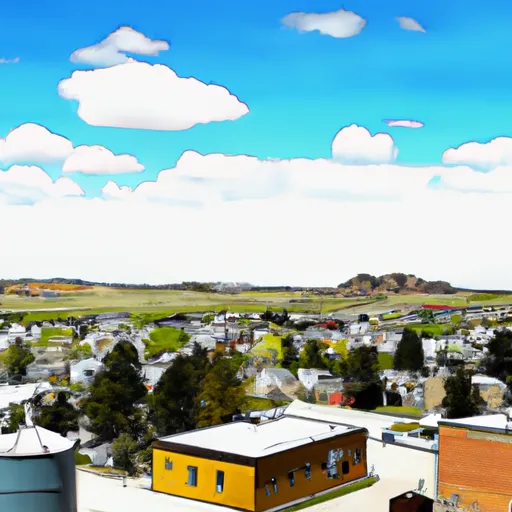-
 Snoflo Premium
Snoflo Premium
Get unlimited access to all our content
With no Ad interruptions! - Start Your Free Trial Login with existing account
Thayne
Eden Index
Climate
6.4
•
Recreation
3.4
•
Community
1.0
•
Safeguard
4.0/10

Thayne, Wyoming is a small town located in Lincoln County, nestled in the picturesque Star Valley. The climate in Thayne is characterized by cold winters and mild summers. Winters can be snowy with temperatures often dropping below freezing, while summers are generally pleasant with temperatures ranging from the 70s to low 80s Fahrenheit. The area experiences a relatively low amount of rainfall throughout the year.
Thayne is surrounded by beautiful natural landscapes, including the Salt River Range to the east and the Caribou National Forest to the west. The town is also home to the Salt River, which adds to the scenic beauty and provides various outdoor recreational opportunities. Fishing enthusiasts can enjoy fly fishing in the river, known for its abundance of trout. Additionally, the nearby Bridger-Teton National Forest offers opportunities for hiking, camping, and wildlife viewing.
In conclusion, Thayne, Wyoming offers a charming small-town experience with a climate defined by cold winters and mild summers. Its proximity to the Salt River and Bridger-Teton National Forest provides ample opportunities for outdoor activities such as fishing, hiking, camping, and wildlife exploration.
What is the Eden Index?
The Snoflo Eden Index serves as a comprehensive rating system for regions, evaluating their desirability through a holistic assessment of climate health, outdoor recreation opportunities, and natural disaster risk, acknowledging the profound impact of these factors on livability and well-being.
Climate Health Indicator (CHI): 6.4
Thayne receives approximately
538mm of rain per year,
with humidity levels near 72%
and air temperatures averaging around
4°C.
Thayne has a plant hardyness factor of
4, meaning
plants and agriculture in this region thrive during a short period during spring and early summer. Most
plants will die off during the colder winter months.
By considering the ideal temperature range, reliable water supplies, clean air, and stable seasonal rain or snowpacks, the Climate Health Indicator (CHI) underscores the significance of a healthy climate as the foundation for quality living.
A healthy climate is paramount for ensuring a high quality of life and livability in a region, fostering both physical well-being and environmental harmony. This can be characterized by ideal temperatures, reliable access to water supplies, clean air, and consistent seasonal rain or snowpacks.
Weather Forecast
Streamflow Conditions
Snake Headwaters
Area Rivers
Snake Headwaters
Snowpack Depths
Snake Headwaters
Reservoir Storage Capacity
Snake Headwaters
Groundwater Levels
Recreational Opportunity Index (ROI): 3.4
The Recreational Opportunity Index (ROI) recognizes the value of outdoor recreational options, such as parks, hiking trails, camping sites, and fishing spots, while acknowledging that climate plays a pivotal role in ensuring the comfort and consistency of these experiences.
Access to outdoor recreational opportunities, encompassing activities such as parks, hiking, camping, and fishing, is crucial for overall well-being, and the climate plays a pivotal role in enabling and enhancing these experiences, ensuring that individuals can engage in nature-based activities comfortably and consistently.
Camping Areas
| Campground | Campsites | Reservations | Toilets | Showers | Elevation |
|---|---|---|---|---|---|
| Allred Flat | 32 | 6,779 ft | |||
| McCoy Creek | 17 | 5,692 ft | |||
| Hobble Creek | 18 | 7,356 ft | |||
| Station Creek | 15 | 5,813 ft | |||
| Murphy Creek | 10 | 6,210 ft | |||
| Tincup | 5 | 5,847 ft | |||
| Diamond Creek | 8 | 6,909 ft | |||
| Moose Flat | 10 | 6,415 ft | |||
| Alpine | 16 | 5,687 ft | |||
| Lynx Creek | 10 | 6,195 ft |
Nearby Ski Areas
Catastrophe Safeguard Index (CSI):
The Catastrophe Safeguard Index (CSI) recognizes that natural disaster risk, encompassing floods, fires, hurricanes, and tornadoes, can drastically affect safety and the overall appeal of an area.
The level of natural disaster risk in a region significantly affects safety and the overall livability, with climate change amplifying these risks by potentially increasing the frequency and intensity of events like floods, fires, hurricanes, and tornadoes, thereby posing substantial challenges to community resilience and well-being.
Community Resilience Indicator (CRI): 1.0
The Community Resilience Indicator (CRI) recognizes that education, healthcare, and socioeconomics are crucial to the well-being of a region. The CRI acknowledges the profound impact of these elements on residents' overall quality of life. By evaluating educational resources, healthcare accessibility, and economic inclusivity, the index captures the essential aspects that contribute to a thriving community, fostering resident satisfaction, equity, and social cohesion.

